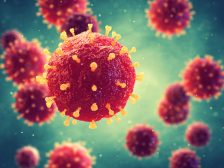
Aerotolerant
adj.
[ˈɛɚ.əˌˈtɒləɹənt]
Definition: capable of tolerating the presence of oxygen in air
Table of Contents
Aerotolerant Definition
The term “aerotolerant” pertains to an organism that does not require oxygen for growth but can tolerate its presence. An aerotolerant organism is classified as an anaerobe. An anaerobic organism (simply, anaerobe) is an organism that can survive or flourish in the absence of oxygen. The aerotolerant anaerobe refers to an organism that is anaerobic as it does not need oxygen to survive and thrive.
An organism has an optimum oxygen concentration range in which it can achieve its maximum growth. However, for an obligate anaerobe, the optimum oxygen concentration is zero. In the presence of oxygen, the obligate anaerobe will die. Conversely, for other types of anaerobes — such as facultative anaerobes and aerotolerant anaerobes — they can thrive despite the presence of oxygen.
Aerotolerant anaerobes can survive in the presence of oxygen but do not use oxygen for growth or metabolism. To meet their energy demand, they carry out the process of fermentation. Some references consider aerotolerant anaerobes as facultative anaerobes because both of them can still survive in the presence of oxygen, unlike obligate anaerobes. However, facultative anaerobes may have the capacity to use oxygen if present; aerotolerant anaerobes do not utilize oxygen.
An aerotolerant is a living thing that does not require oxygen to maintain its metabolic functions yet can live in the presence of oxygen. An aerotolerant is considered an anaerobe because it does not use oxygen to oxidize molecules during energy production. Etymology: Greek āero-, from āēr, air + French tolérant, from Latin tolerāns, present participle of tolerāre, to bear. See also facultative anaerobe, microaerophile, obligate anaerobe.
What is Aerotolerance in Microbiology?
Aerotolerance is the capacity of an organism to tolerate the presence of oxygen in the air. In microbiology, the aerotolerance of a microorganism can be tested through the Aerotolerance Test, which makes use of thioglycollate broth. It is a medium designed for allowing the growth of bacteria in different layers. The layering of bacterial growth in this culture medium indicates which bacteria are obligate aerobes, obligate anaerobes, microaerophiles, facultative anaerobes, and aerotolerant anaerobes based on where they will grow in the culture medium. See Figure 1.

The opposite occurs in tube B. Bacteria show growth at the bottom of the tube. These are obligate anaerobes and they do not live in the existence of oxygen.
In tube C are facultative anaerobes that grow at the top as well as at the bottom of the tube. Facultative anaerobes flourish in the presence and also in the absence of oxygen. In absence of oxygen, they grow by fermentation.
The bacteria in tube D are unresponsive to the existence of oxygen. Neither they are using oxygen nor do they get harmed by its presence. They grow by fermentative metabolism. They are termed aerotolerant organisms.
The bacteria in tube E shows a ‘Goldilocks’ culture. The bacteria require the right level of oxygen for growth, neither too much nor too little, almost 1-10%. These microaerophiles are such a type of bacteria that require a minimum level of oxygen.
Watch this vid: Fluid Thioglycollate Media & Aerotolerance
Evolution of Aerotolance in Some Anaerobes
For the existence of life, there is no need for molecular oxygen every time. The first evidence of life may be attributed back to a time when the earth’s atmosphere was very reducing. At that time free oxygen was nearly non-existent, only cyanobacteria were the source of oxygen as a by-product of photosynthesis. Through time, the iron level in the seas was no longer enough to absorb the oxygen in the atmosphere. As a result, the level of oxygen in the atmosphere began to rise. This event, known as the Great Oxygenation Event (or the Oxygen Revolution), resulted in the huge destruction and extinction of many oxygen-intolerant organisms.
When the environment turned from anaerobic to aerobic, some of the previously anaerobic organisms evolved and adapted to it. The oxygen occurred in reduced forms, e.g., hydroxyl radicals, peroxide, or superoxide. These forms of oxygen were lethal to obligate anaerobes. Due to this harmful exposure to oxygen, some of them eventually adapted through time by acquiring ways on how to protect themselves. Variation to an aerobic environment offered such organisms a wider range of ecological places to survive.
Lactic acid bacteria are a group of bacteria that is an example of organisms that adapted to an aerobic environment. They are essentially fermenters, carrying out fermentation to meet their energy demand. They may not have the enzymes required for aerobic life but, to some extent, many of them have become aerotolerant. Nevertheless, in newer studies, many strains have been shown to use oxygen as a substrate.
Why is Oxygen Destructive to Anaerobes?
The oxidative properties of reactive species of oxygen are so intense that obligate anaerobes could not withstand it. From the partial reduction of oxygen, some unstable molecules and ions are formed that can damage cellular structure or macromolecules.
Some examples of reactive oxygen species are:
- singlet oxygen (O2•)
- peroxides (H2O2)
- hypochlorite ion (OCl−)
- hydroxyl radical (OH•)
- superoxide (O2−)
How Aerotolerant Anaerobes Survive Aerobic Environment
Aerotolerant anaerobes are able to survive even after exposing to air with oxygen because they employ strategies to protect themselves. One of them is to produce enzymes that counter the destructive effect of some lethal forms of oxygen. Superoxide dismutase, for instance, is an enzyme capable of converting the superoxide anion into ground-state oxygen and hydrogen peroxide. Hydrogen peroxide, in turn, is degraded by another enzyme, e.g., catalase or peroxidase. (Hentges, 2021)

How Aerotolerant Anaerobes Produce Energy
Adenosine triphosphate is a form of energy that the human body made by using oxygen. ATP is required for doing all the tasks. ATP is formed from the food through the process of aerobic cellular respiration. In aerobic cellular respiration, the body converts the food energy into ATP.
If oxygen is required for the production of ATP, how can aerotolerant anaerobic bacteria survive without it? Aerotolerant bacteria use fermentation instead of aerobic cellular respiration. Although fewer ATP are produced by fermentation than aerobic respiration, fermentation has been sufficient to provide them with adequate cellular energy. (Study.com, 2021)
Where are Aerotolerant organisms found?
Many ecosystems still do not have molecular oxygen. Some are found in severe conditions, like in the earth crust or depth of the oceans while others are common, like drains, marshlands, and swamps. Within the bodies of humans and animals, there are certain regions with little or almost no oxygen thus they create an anaerobic habitat for microbes.
Aerotolerant Anaerobe Examples
What organisms are aerotolerant? Some examples of aerotolerant anaerobes are as follows:
- Streptococci and Lactobacillus spp. found in oral microbiota are the main aerotolerant anaerobic bacteria.
- An example of a microaerophile is Campylobacter jejuni which shows growth in less amount of oxygen. It causes gastrointestinal infections.
- Cutibacterium acnes is also an example of aerotolerant anaerobes.
Try to answer the quiz below to check what you have learned so far about aerotolerants.
References
- Aerotolerant anaerobe. (2021). TeacherInABox.org.au. Retrieved 13 Dec, 2021, from http://kolibri.teacherinabox.org.au/modules/en-boundless/www.boundless.com/definition/aerotolerant-anaerobe/index.html
- CNX, O. (2021). Oxygen Requirements for Microbial Growth. Retrieved 13 Dec, 2021, from https://courses.lumenlearning.com/microbiology/chapter/oxygen-requirements-for-microbial-growth/
- Hentges, D. J. (2021). Anaerobes: General Characteristics. Nih.gov; University of Texas Medical Branch at Galveston. https://www.ncbi.nlm.nih.gov/books/NBK7638/
- King, K. Y., Horenstein, J. A., & Caparon, M. G. (2000). Aerotolerance and peroxide resistance in peroxidase and PerR mutants of Streptococcus pyogenes. Journal of bacteriology, 182(19), 5290-5299.
- Study.com. (2021). Aerotolerant Anaerobes. Retrieved 13 Dec, 2021, from https://study.com/academy/lesson/aerotolerant-anaerobes-definition-examples.html
©BiologyOnline.com. Content provided and moderated by Biology Online Editors.








